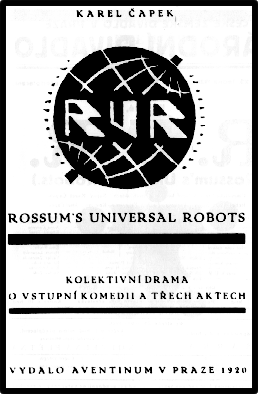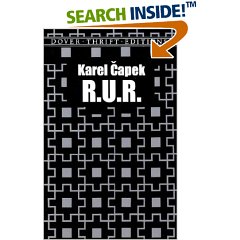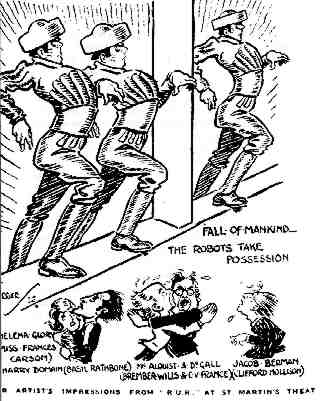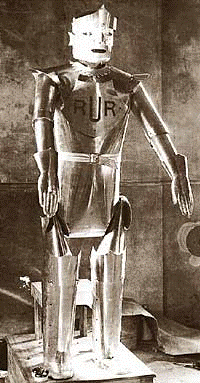R.U.R.- Rossum's Universal Robots (1921)
Brief Summary & Analysis of Karel Capek's play, "Rossum's Universal Robots"
Background / Plot:
In Capek’s play, Rossum’s Universal Robots, Robots are mass produced by other Robots on assembly lines. The idealistic Helena Glory, President of The Humanity League, believes that Robots have (or are developing) souls, and feels that they should be freed.
The Robots can clearly think for themselves, though they’re content to serve. They remember everything, but think of nothing original or unique. The eccentric scientist Old Rossum was bent on assuming the role of the Creator by artificially reproducing a man in intricate detail, while the pragmatic economist/industrialist Young Rossum produces stripped-down versions of humanity to be sold as inexpensive workers—Robots.
 
Buy it!!
courtesy of jerz.setonhill.edu
Every so often, one of the Robots will throw down their work and begin to gnash their teeth. While many disagree (including Dr. Hellman, psychologist in Chief); Helena Glory feels that it’s evidence and a sign of the emerging soul of Robots. After marrying Harry Domin, General Manager of R.U.R., Helena presses scientists to modify some of the robots, so that their “souls” could develop quicker and more fully. Meanwhile, the drive for industrial civilization is at an all-time high, and fertility rates are dropping very low. One of Helena’s modified Robots issues a foreshadowing plan, “Robots of the world, you are ordered to exterminate the human race. . . Work must not cease!”
Domin possesses the formulas for creating the Robots, and plans to use it for a bargaining tool. Helena, ignorant of the true threat at hand, burns the formulas. The Robots gather and kill all the humans, leaving only the Clerk of R.U.R. The Robot leader, Damon tries and tries to get the Clerk (called Alquist) to discover how to help them populate the earth, but to no avail—as they don’t know how to produce other Robots.
Eventually, two Robots, Helena (a beautiful modified Robot named after Helena Glory); and another Robot named Primus fall in love. With the blessing of Alquist, the lovers are married, and renamed Adam and Eve (Jerz, "R.U.R.")

Fall of Mankind
courtesy of jerz.setonhill.edu
Analysis:
Karel Capek’s play serves as almost the perfect introduction to this theme in SF literature and cinema. The story delves into the dynamics of the unique relationship between the Robots and the Humans who created them—both their frame of mind, and their subsequent actions.
The notion that the Robot could be more than just “lights and clockwork” is a contribution to SF literature that, along with Shelley’s Frankenstein, R.U.R. can stake a claim in. Besides the theme of the Dystopia caused by the modified Robots (ironically modified by the very Humans they destroyed), Karel Capek’s play also explores the possible development of a “soul” in Robots.
R.U.R. implies that not only are Robots capable of physical labor, but that they could conceivably—given the right motivation and/or environment develop the very emotions that make Humans so unique. Capek seems to suggest that Robots could one day experience not only the joys of love and hope—but the pain of fear, envy, and hate as well.

The R.U.R. robot which appeared in an adaption of Czech
author Karel Capek's Rossum's Universal Robots.
Circa 1930's.
courtesy of thetech.org
|
![]()